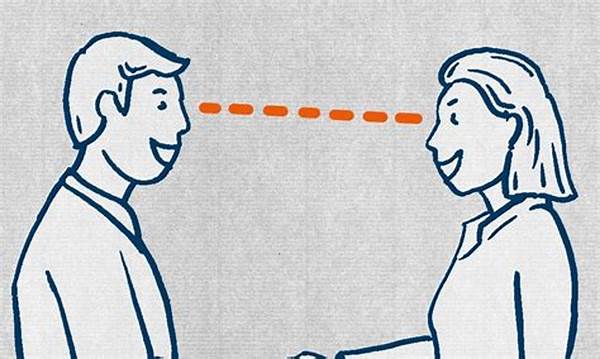The interplay between eye contact and trust has long intrigued psychologists and communication experts. As a fundamental aspect of human interaction, eye contact serves as a non-verbal cue that can influence perceptions and behaviors dramatically. Understanding the influence of eye contact on trust becomes pivotal, especially in contexts requiring interpersonal engagement or negotiation. Numerous studies have sought to decipher this connection, elucidating both the conscious and subconscious impact of eye contact on the formation and maintenance of trust.
Read Now : Comparative Study Of Dating Traditions
The Psychological Basis of Eye Contact and Trust
The influence of eye contact on trust has its roots deeply embedded in psychological principles. Eye contact is often interpreted as a sign of confidence and sincerity. When individuals engage in direct eye contact, it suggests attentiveness, interest, and openness. These attributes are crucial in fostering trust, as they create a perception of authenticity and reliability. Conversely, avoiding eye contact can be perceived as evasive or insincere, potentially leading to distrust. Various psychological frameworks suggest that eye contact activates specific areas of the brain associated with social cognition, which underscores its significant influence on interpersonal relationships. Understanding these dynamics highlights the vital role of eye contact in effective communication and trust-building.
Key Factors Affecting the Influence of Eye Contact on Trust
1. Cultural Variations: The influence of eye contact on trust can significantly vary across cultures. In some societies, direct eye contact is a sign of confidence, while in others, it may be considered disrespectful.
2. Contextual Considerations: The setting or context in which eye contact occurs affects its influence. Professional environments may demand different eye contact norms compared to personal or informal settings.
3. Duration of Eye Contact: The length of eye contact can alter its effect. Sustained eye contact might build trust or, alternatively, induce discomfort if excessively prolonged.
4. Reciprocity: Mutual eye contact strengthens the bidirectional influence of eye contact on trust, fostering a sense of equal engagement and understanding.
5. Individual Differences: Personal characteristics such as shyness or extroversion can moderate how eye contact impacts trust formation.
Practical Applications and Implications
The influence of eye contact on trust has practical implications across various domains. In business negotiations, for instance, maintaining eye contact can enhance the perception of honesty and transparency, potentially leading to more favorable outcomes. Similarly, in therapeutic settings, effective use of eye contact can help build the necessary trust between patients and healthcare providers. Moreover, understanding how eye contact influences trust can assist educators in creating a more engaging classroom environment, thereby promoting better learning outcomes. In personal relationships, eye contact can serve as a tool to reinforce connections and establish deeper emotional bonds. Recognizing these applications of eye contact in fostering trust underscores its multifaceted role in human interactions.
Read Now : Period Drama Interracial Romances
Challenges in Interpreting Eye Contact
Interpreting the influence of eye contact on trust is fraught with challenges. Firstly, individual variability in perceiving eye contact means that its impact can differ widely from person to person. Secondly, cultural differences can lead to misinterpretations, as what might be a trust-building gesture in one culture may be offensive in another. Thirdly, the context in which eye contact occurs plays a significant role; a friendly glance in a social setting might not have the same impact in a formal meeting. Fourthly, the intent behind eye contact can be misjudged, making trust assessments precarious. Lastly, situational variables, such as lighting and physical barriers, can affect the perception and effectiveness of eye contact.
Eye Contact in Digital Communication
In the digital age, the influence of eye contact on trust has evolved, especially with the prevalence of virtual communication platforms. While digital mediums pose challenges for maintaining eye contact, they also offer unique opportunities to understand its influence in new contexts. Video conferencing tools attempt to replicate the eye contact experience, allowing participants to engage in virtual eye contact. However, the extent to which this virtual eye contact mirrors face-to-face interactions remains debatable. Nevertheless, digital communication encourages exploration into how technology can enhance or diminish the influence of eye contact on trust.
Strategies for Effective Eye Contact
To harness the influence of eye contact on trust effectively, several strategies can be employed. First, being mindful of cultural norms ensures that eye contact is used appropriately. Second, adjusting eye contact according to the context—be it professional, social, or academic—can prevent misunderstandings. Third, practicing reciprocity in eye contact fosters mutual engagement. Fourth, being aware of personal tendencies and adjusting accordingly could enhance interpersonal communication. Finally, in virtual settings, making an effort to look into the webcam rather than at the screen can simulate a more authentic eye contact experience.
Summation of Eye Contact’s Role
In summarizing the influence of eye contact on trust, it becomes evident that this non-verbal cue plays an indispensable role in shaping human interactions. Across diverse settings and cultures, eye contact remains a pillar of communication that conveys confidence, sincerity, and attentiveness. Despite the complexities introduced by individual differences and contextual variables, the fundamental importance of eye contact in building and maintaining trust persists. As digital communication continues to evolve, the traditional understanding of eye contact may transform, yet its core influence on trust development will likely remain an intrinsic component of personal and professional relationships. Understanding these dynamics not only enhances effective communication but also enriches the quality of human connections.
